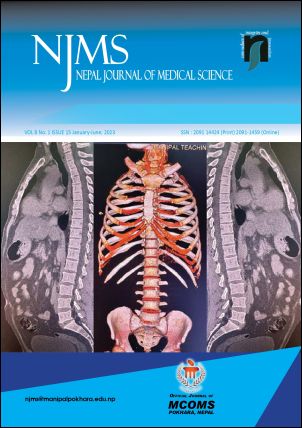Radiological Evaluation of Uncinate Process Variations using Multidetector Computed Tomography
DOI:
https://doi.org/10.3126/njms.v8i1.54305Keywords:
Computed Tomography, Endoscopy, Paranasal SinusesAbstract
Introduction: Functional endoscopic sinus surgery has emerged as a superior technique in sinus surgery with a lower incidence of associated complications as compared to traditional surgeries; however, it still carries risks of possible complications, some of which could be attributable to the variations that exist in the nose and paranasal sinus anatomy. Variations in the uncinate process, one of the important structural landmarks in functional endoscopic sinus surgery can have implications during sinus surgery. Therefore, identifying the variations in the uncinate process becomes a very important consideration. The objective of this study was to identify the variations of the uncinate process on Multidetector Computed Tomography of paranasal sinuses
Methods: This cross-sectional study was conducted in the Department of Radiodiagnosis, Birat Medical College and Teaching from December 2021 to June 2022 after obtaining ethical clearance from IRC. A total of 240 participants referred to the Department of Radiodiagnosis for CT of paranasal sinuses were included in the study.
Results: The most frequent superior attachment of uncinate was found to be Type I and the least common was Type IV. The least frequent variation was UP pneumatisation. Most of the cases showed typical angulation followed by medial orientation and lateral orientation.
Conclusion: Variations in the uncinate process exist and Multidetector CT is a commendable tool for identifying these variations.
Downloads
Downloads
Published
How to Cite
Issue
Section
License
Copyright (c) 2023 Nepal Journal of Medical Sciences

This work is licensed under a Creative Commons Attribution 4.0 International License.
Copyright © by Nepal Journal of Medical Sciences. The ideas and opinions expressed by authors of articles summarized, quoted, or published in full text in this Journal represents only opinions of authors and do not necessarily reflect the official policy of Nepal Journal of Medical Sciences or the institute with which the author(s) is (are) affiliated, unless so specified.




